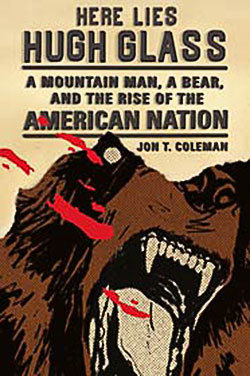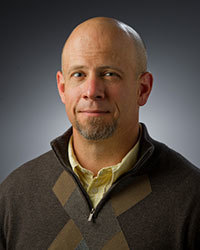
Jon T. Coleman, professor of history at the University of Notre Dame, is interested in the truths that hide in lies.
In his new book, “Here Lies Hugh Glass: A Mountain Man, A Bear, and the Rise of the American Nation,” the historian uses a whopper of a story to explore not how the West was won but how its image was built.
Mountain man Hugh Glass’ lingering lore begins in the wilds of South Dakota, where a grizzly bear mauls him in 1823.
According to the story, the party Glass traveled with killed the bear, but Glass had been mortally wounded. The expedition leader told two men to stay behind to bury Glass if he died or, should he recover, to lead him back to civilization.
But the duo skipped out early, taking Glass’ gear with them. Barely able to walk or fend for himself, Glass crawled back to the trading post at Fort Kiowa, hundreds of miles away, vowing a revenge that never came to pass.
Of all the tall tales told from that era, Coleman, a faculty member in the College of Arts and Letters’ Department of History, says he was drawn to this one in particular because of the role nature plays in the plot.
“Glass struggled with nature instead of other human beings. I thought he could bridge the mythic West and environmental history.”
He explains, “I’m trying to show how working people like Glass helped Americans define their nation as different and exceptional. They wanted the nation to sprout from the soil and to be ingrained in people. This naturalizing process, however, wasn’t pleasant. People close to nature — working people — suffered.
“Nationalists ‘kidnapped’ working people as symbols, while they tried to distance their own bodies from toil and violence. The kicker is that this process of cultural appropriation gave marginal people like Glass some influence on the national character. If you read the stories a certain way,” Coleman says, “I think you can see them messing with their audience.”
At the same time, far from accepting such tales as gospel, readers in Glass’ day questioned all these stories.

“The mountain men were seen as shifty liars even as people celebrated them as environmental Americans,” Coleman says. “That’s how cultural appropriation worked. They needed men like Glass to establish American exceptionalism, but they also wanted to quarantine them on the frontier. No one wanted Glass to come back.”
Glass’ epic crawl, he adds, was part of the growing pre-Mark Twain tradition of tales concerning con artists and tricksters that some also saw as integral to the concept of the West, with Glass’ experience an ultimate wilderness adventure that still resonates today.
“Survivalism has become rampant since the 1970s, and that’s why Glass is still around. Americans still seem interested in working people’s struggles against nature — like ‘Deadliest Catch’ (the ‘reality’ TV show about Alaskan crab fishermen). The difference is that today,” Coleman says, “Glass is held up as a role model. He has become a life coach for the end times.”
With little actually known for sure about Glass, Coleman says his book is more a missing person report than a biography.
“The main challenge of the research and writing was the fact that Hugh Glass left almost nothing behind. The book had to be about the stuff around him, his social, environmental and cultural surroundings. It would have been much easier to have a personal archive I could park myself in for an extended period — but then it would have been a far less interesting book to write.”
To research the mythic story of Glass, Coleman traveled to the Missouri Historical Society in St. Louis to pore over materials related to the western fur trade. He also spent time in the Western collections of the Newberry in Chicago. “Many documents involving the American fur trade had been published over the years, and I tried to reread famous fur trade accounts like James Beckwourth’s autobiography and George Ruxton’s ‘Life in the Far West’ with new eyes.”
Coleman notes that “in general, I was surprised most by the material people have known about for a long time — the published mountain man memoirs. Historians have read them for reality of the West, the details of the fur trade and such, but I was overtaken by the leaps of fancy and outright lies contained in them. I’m very interested in lies.”
Along with the legacy of such lies, Coleman’s work is informed by pop culture across eras, from writers in the 1800s looking to make a buck off their versions of the West — including Herman Melville — to references to Homer Simpson, Woody Allen’s “Zelig” and the Coen brothers’ “The Big Lebowski.”
“Glass was a pop-culture creation from the start,” Coleman says. “That’s why we know about him at all. So it seemed essential to trace his journey through popular culture as well as the wilderness. Like Glass, I swim in pop culture, and since I write a self-reflective type of history, this comes out.”
The approach has meant he has not had problems getting his books into print. “Publishers, I think, see my unconventional style as an asset.”
The content also resonates with modern readers: Both of his books, Coleman says, “play with the relationships of social, cultural and environmental history — and they have a good deal of blood and violence.”
Coleman says he signed a contract for his first book before he had even finished the dissertation. That book, “Vicious: Wolves and Men in America” (Yale University Press, 2004), won the American Historical Association’s 2005 John H. Dunning Prize and the Western History Association’s 2005 W. Turrentine Jackson Award.
His next project is a textbook, “The American West: A New Interpretive History (Revised Edition)” with John Mack Faragher and Robert Hine.
Coleman’s research and teaching at Notre Dame focus on early American history and the American West. He is also on the faculty of the University’s History and Philosophy of Science Graduate Program.
In spring 2012, he taught an undergraduate course on the American West and a graduate seminar on environmental history and received a Rev. Edmund P. Joyce, C.S.C., Award for Excellence in Undergraduate Teaching.
Coleman says he frequently talks about his writing in the classroom.
“I use parts of the books as examples of how I write,” he says. “The actual topics come up less often, but I do bring up wolves, bears and mountain men every so often.”
Originally published by Mike Danahey at al.nd.edu on May 23, 2012.